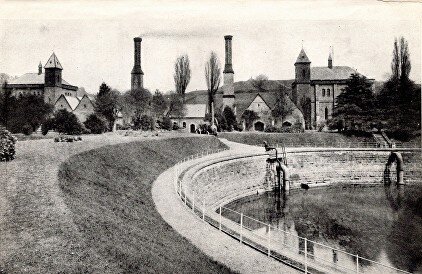
Water Supply and the Derby Water Works
In the 17th and 18th centuries there was a plentiful supply of drinking water for the people of Little Eaton. The village's position in the valley of Bottle Brook and its proximity to the River Derwent meant the various wells in the area were seldom without a plentiful supply of water. Virtually every house had its own well or access to one close by. A survey at the time suggested that there were 49 wells serving the then population of about 400. Clearly the water obtained would not be subject to the treatment regimes in existence today.
Wooden pipes made by boring holes through timber using a boring machine powered by a water engine designed by George Sorocold
About the same time various water supply schemes were in existence in nearby Derby. These largely depended on extraction from the River Derwent and eventually a piped system was installed to serve the area around the cathedral. Over the years various extensions of this were carried out but again pre-treatment was minimal and largely involved some form of crude filtration. By the middle of the 19th century it was apparent that these water supply systems were inadequate as Derby's population grew.
In 1848 the new Derby Corporation Waterworks was built at Little Eaton and on the 30th of June that year the Derby Waterworks Act received Royal Assent. A company with a working capital of £40,000 was formed for “the better supplying with water the Borough of Derby and certain parishes and places thereto in the County of Derby” Under the powers of the Act works were constructed in 1849 and 1850 comprising pipes to extract from the valley of Bottle Brook and the River Derwent. Pumps delivered the water to the works and an 18 inch main delivered the filtered water to Derby.
Further bills in 1868 and 1873 conferred additional capital raising powers to extend the supply and a new service reservoir was built at Littleover. In 1879 under the Derby Improvement Act the whole of the works was purchased by Derby Corporation for £351,000. Further extensions of the system were carried out and the supply and use of water became subject to the provisions of the Public Health Act of 1875 and for the first time water was regarded as valuable commodity although things were still a long way from the regulations of today.
During these years the water passing through and being treated at the Little Eaton Works was being supplied to various parts of Derby and beyond. The years when mains water arrived at certain locations are:
1873 Derby Centre
1873 Littleover/Mickleover/ Mackworth/Allestree/Breadsall/Chaddesden
1890 Little Eaton
1892 Alvaston/Boulton
Water treatment and pumping in Little Eaton
In the case of Little Eaton all of the extraction of water to the Works caused the wells mentioned at the beginning to dry up as the water table began to shrink ! The provision of mains water to the village became essential and the first water main was constructed on Alfreton Road followed by Duffield Road and then across Jack O' Darley Bridge to the north end of the village.
Carsington reservoir
The water supply to the works down the Derwent Valley has been much extended with the reservoirs in the upper Derwent valley as well as Carsington. Water extraction takes place further north to supply the city of Sheffield and some of the water treated at Little Eaton supplies parts of Nottingham.
The treatment works still stands on the original site at Little Eaton but is now run by the Severn Trent Water Authority formed in 1974. The water treatment these days is a far cry from the basic treatment of the early days and includes fine filtration, removal of organic material and bacteriological treatment. Systems allow the outgoing treated water to be diverted if problems occur in any part of the supplied area. As you would expect the whole system is run from a central computerised control room.
More information on the Water History of Derbyshire.



